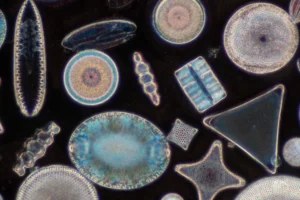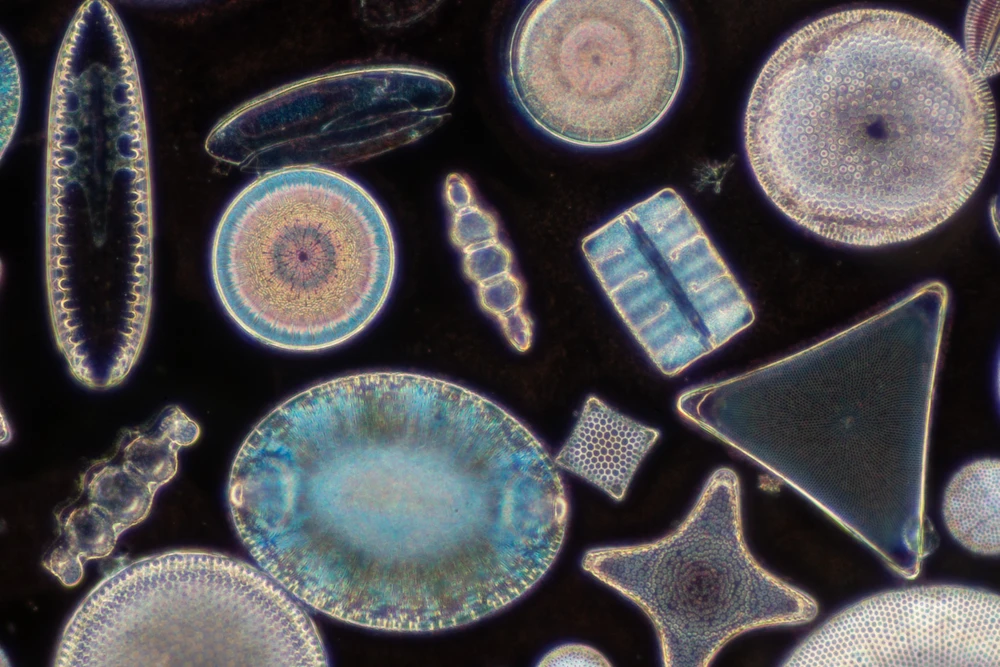Scientists have made a remarkable achievement, reviving single-celled algae of the Skeletonema marinoi species, which has lain in the bottom sediments of the Baltic Sea for nearly 7,000 years. This discovery sheds new light on the survival abilities of microorganisms in extreme conditions and opens up new prospects for research in various scientific fields.

Diatoms under the microscope, photo: Adobe Stock
Characteristics of diatoms
Diatoms (Bacillariophyta) are microscopic, single-celled algae that play a key role in aquatic ecosystems. Their cells are surrounded by siliceous carapaces with a variety of symmetrical shapes, which makes them of interest to biologists and ecologists. Diatoms are a major component of phytoplankton and are estimated to be responsible for producing between 20% and 50% of the Earth’s oxygen. Under unfavorable environmental conditions, they are able to go into dormancy, forming spores with minimal metabolism, enabling them to survive in harsh conditions for long periods of time.
In 2021, a team of researchers led by Dr. Sarah Bolius of the Leibniz Institute for Baltic Sea Research Warnemünde conducted a research expedition aboard the Elisabeth Mann Borgese. During this expedition, sediment samples were taken from a depth of 240 meters in the eastern Gotland Deep, a region located between the island of Gotland and the coast of Latvia. Analysis of these sediments that represent a time span of about 7,000 years, made it possible to identify and isolate living cells of Skeletonema marinoi. After being placed in favorable laboratory conditions, the algae recovered their full photosynthetic and reproductive capacity, demonstrating their remarkable ability to survive in extreme conditions for millennia.
Survival mechanisms of Skeletonema marinoi
The ability of Skeletonema marinoi to survive in bottom sediments for such a long time without access to light and oxygen suggests the existence of unique adaptive mechanisms. Genomic and transcriptomic studies of this species indicate the presence of genes responsible for the formation of survival forms and efficient DNA repair systems. These mechanisms allow diatoms to withstand oxidative stress and other adverse environmental conditions. Further studies of these processes may provide valuable information on the evolution of marine microbial survival strategies.
The discovery of Skeletonema marinoi’s ability to survive for long periods in a dormant state has potential applications in various fields of science and technology. In biotechnology, understanding the survival mechanisms of these diatoms could contribute to the development of new methods for preserving microbial cultures or producing biofuels. In astrobiology, research on S. marinoi may provide clues to the possibility of the existence of life in extreme conditions on other planets, where organisms would have to survive long periods of dormancy in hostile environments.
Relevance to ecology and forensic science
Diatoms, such as Skeletonema marinoi, play an important role in aquatic ecosystems, influencing biogeochemical cycles and primary production. Their ability to survive in bottom sediments can affect the structure and functioning of ancient marine ecosystems. In addition, the analysis of diatoms in environmental samples has applications in forensics, including diagnosing the causes of drownings or identifying the locations of people, highlighting the interdisciplinary importance of these microorganisms.
Sources: sciencenewstoday.org, prenumeruj.forumakademickie.pl, journals.asm.org







